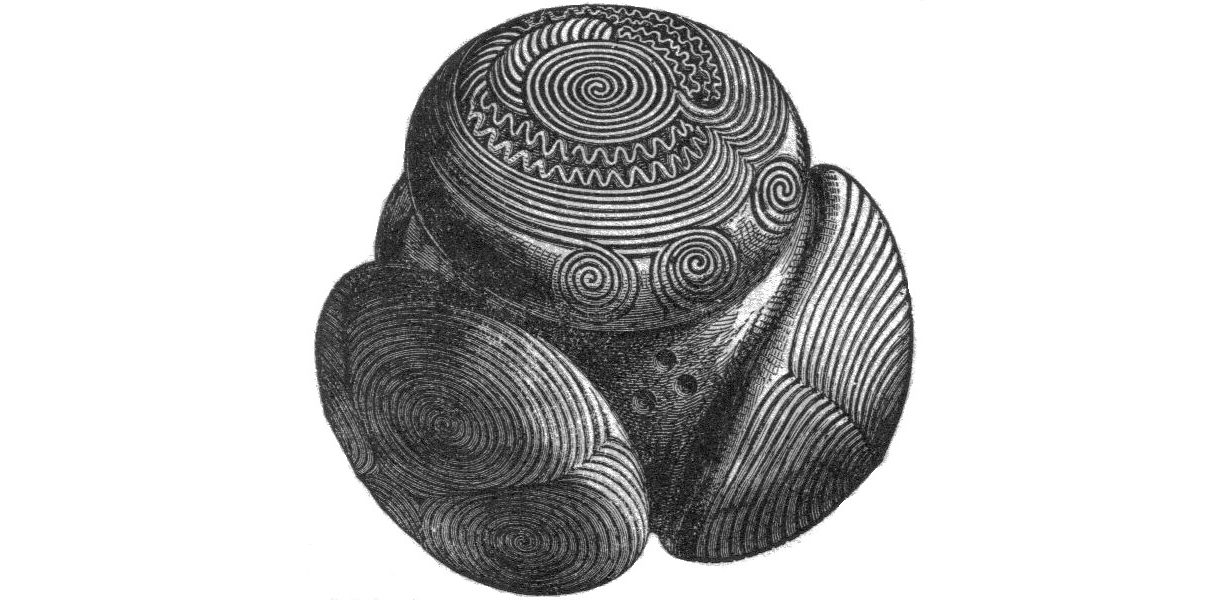More than 200 years ago, mysterious stone balls began to be unearthed in the UK. These oddly geometric stones date back to the Neolithic period, approximately 5,000 years ago. With the majority appearing in Aberdeen, Scotland, the now 500-strong collection has been found in Ireland, England, and even Norway.
Made from various types of stone including sandstone and granite, with one even being coated in a black fish-based paste, the balls in the collection all share remarkable similarities despite their relative geographical spread.
While their uniform size measures around 70 millimeters (2.75 inches) in diameter, with the exception of a larger collection measuring 114 millimeters (4.5 inches), the balls all display varying degrees of workmanship.
They all feature between three and 160 projectile knobs or disks, with six being the most common. Some of them feature distinctly decorative engravings of circles and swirls, while others are left blank. It’s believed the stones will have taken several years to carve, with some of the more intricate pieces even taking multiple generations.
One of the most intricate, well preserved, and well-known pieces is the Towie ball.
The Towie ball
Measuring approximately 73 millimeters (2.87 inches) and weighing 500 grams (17.6 ounces), the Towie ball gets its name from its place of discovery on the slopes of Glaschul Hill, Towie, Scotland.
Donated to the then-named National Museum of Antiquities of Scotland in 1860 on behalf of farmer James Kesson, the ball features four prominent disks, three of which are intricately carved and the fourth blank.
While the fourth blank disk has led many to believe the engravings on the ball are unfinished, there are theories surrounding the use of the Towie stone that suggest this was intentional and meant to be used as the ball’s base.
Rock art in Achnabreck, roughly 200 miles from Towie, features a cup in which a ball with the Towie ball’s properties fits. The engravings around the cup are thought to be part of a prehistoric sundial or lunisolar calendar, whereby pouring water or oil over the ball fills the rivets in the rock and reflects the sun and moon’s light.
The exact use of the Towie ball and all the other stones in the collection, however, is still widely speculated.
The Towie stone is now held at the National Museums Scotland, where they have created a 3D virtual model that enables viewers to see intricate details of the ball from anywhere in the world. The model is so detailed, in fact, that it has enabled researchers to notice intricate carvings that were not spotted under real-world observation.

Theories surrounding their use
As with the Towie ball, there are theories around the entire collection being a form of timekeeping for the people of the Neolithic. Acting as the equivalent of a modern wristwatch, their polished appearance may have been used as a form of portable spherical sundial.
Some theories also point to the religious beliefs that farming communities held at the time, focusing on times of the year like winter and summer solstice. This again points to their use as lunisolar and tidal calendars that may have helped communities detect seasonal changes.
The symbols engraved on some of the stones may have also related to the religious and ceremonial uses for the balls. With highly intricate and time-consuming construction, it’s thought the pieces would be considered very valuable and precious, and may have been used specifically for religious or spiritual ceremonial practices.
Similarly, the value these items held could have meant they were used as a status symbol, owned by the most wealthy and powerful members of the community.
There are, however, many theories that point to a more practical use of the stones. Some believe they may have been used as weighing scales for transactional purposes, which would explain their abundance.
Some suggest they may have been used in a form of ancient throwing game, or even shot from a sling as a form of blunt-force weaponry, although there’s no physical evidence on the stones that show the expected wear and tear these activities would undoubtably have.
Any assumptions of the use of these unusual stones will always be tentative, as the communities using them hadn’t yet learnt to write, meaning there’s no written record. The remarkably good conditions of all the stones in the collection, however, shows they were once cherished by their communities.
Source Link: What Are These Mysterious 5,000-Year-Old Geometric Stone Balls?